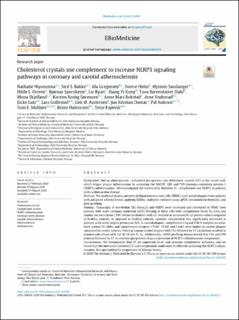Cholesterol crystals use complement to increase NLRP3 signaling pathways in coronary and carotid atherosclerosis
| dc.contributor.author | Niyonzima, Nathalie | |
| dc.contributor.author | Bakke, Siril S. | |
| dc.contributor.author | Gregersen, Ida | |
| dc.contributor.author | Holm, Sverre | |
| dc.contributor.author | Sandanger, Øystein | |
| dc.contributor.author | Orrem, Hilde Lang | |
| dc.contributor.author | Sporsheim, Bjørnar | |
| dc.contributor.author | Ryan, Liv | |
| dc.contributor.author | Kong, Xiang Yi | |
| dc.contributor.author | Dahl, Tuva Børresdatter | |
| dc.contributor.author | Skjelland, Mona | |
| dc.contributor.author | Sørensen, Kirsten | |
| dc.contributor.author | Rokstad, Anne Mari A. | |
| dc.contributor.author | Yndestad, Arne | |
| dc.contributor.author | Latz, Eicke | |
| dc.contributor.author | Gullestad, Lars | |
| dc.contributor.author | Andersen, Geir Øystein | |
| dc.contributor.author | Damås, Jan Kristian | |
| dc.contributor.author | Aukrust, Pål | |
| dc.contributor.author | Mollnes, Tom Eirik | |
| dc.contributor.author | Halvorsen, Bente | |
| dc.contributor.author | Espevik, Terje | |
| dc.date.accessioned | 2020-10-12T12:22:24Z | |
| dc.date.available | 2020-10-12T12:22:24Z | |
| dc.date.created | 2020-10-08T11:06:54Z | |
| dc.date.issued | 2020 | |
| dc.identifier.issn | 2352-3964 | |
| dc.identifier.uri | https://hdl.handle.net/11250/2682262 | |
| dc.description.abstract | Background: During atherogenesis, cholesterol precipitates into cholesterol crystals (CC) in the vessel wall, which trigger plaque inflammation by activating the NACHT, LRR and PYD domains-containing protein 3 (NLRP3) inflammasome. We investigated the relationship between CC, complement and NLRP3 in patients with cardiovascular disease. Methods: We analysed plasma, peripheral blood mononuclear cells (PBMC) and carotid plaques from patients with advanced atherosclerosis applying ELISAs, multiplex cytokine assay, qPCR, immunohistochemistry, and gene profiling. Findings: Transcripts of interleukin (IL)-1beta(b) and NLRP3 were increased and correlated in PBMC from patients with acute coronary syndrome (ACS). Priming of these cells with complement factor 5a (C5a) and tumour necrosis factor (TNF) before incubation with CC resulted in increased IL-1b protein when compared to healthy controls. As opposed to healthy controls, systemic complement was significantly increased in patients with stable angina pectoris or ACS. In carotid plaques, complement C1q and C5b-9 complex accumulated around CC-clefts, and complement receptors C5aR1, C5aR2 and C3aR1 were higher in carotid plaques compared to control arteries. Priming human carotid plaques with C5a followed by CC incubation resulted in pronounced release of IL-1b, IL-18 and IL-1a. Additionally, mRNA profiling demonstrated that C5a and TNF priming followed by CC incubation upregulated plaque expression of NLRP3 inflammasome components. Interpretation: We demonstrate that CC are important local- and systemic complement activators, and we reveal that the interaction between CC and complement could exert its effect by activating the NLRP3 inflammasome, thus promoting the progression of atherosclerosis. | en_US |
| dc.language.iso | eng | en_US |
| dc.publisher | Elsevier | en_US |
| dc.rights | Attribution-NonCommercial-NoDerivatives 4.0 Internasjonal | * |
| dc.rights.uri | http://creativecommons.org/licenses/by-nc-nd/4.0/deed.no | * |
| dc.title | Cholesterol crystals use complement to increase NLRP3 signaling pathways in coronary and carotid atherosclerosis | en_US |
| dc.type | Peer reviewed | en_US |
| dc.type | Journal article | en_US |
| dc.description.version | publishedVersion | en_US |
| dc.source.journal | EBioMedicine | en_US |
| dc.identifier.doi | https://doi.org/10.1016/j.ebiom.2020.102985 | |
| dc.identifier.cristin | 1838152 | |
| dc.description.localcode | © 2020 The Author(s). Published by Elsevier B.V. This is an open access article under the CC BY-NC-ND license (http://creativecommons.org/licenses/by-nc-nd/4.0/) | en_US |
| cristin.ispublished | true | |
| cristin.fulltext | original | |
| cristin.qualitycode | 1 |

